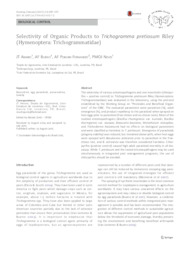Selectivity of organic products to Trichogramma pretiosum Riley (Hymenoptera: Trichogrammatidae).
Selectivity of organic products to Trichogramma pretiosum Riley (Hymenoptera: Trichogrammatidae).
Author(s): AMARO, J. T.; BUENO, A. de F.; POMARI-FERNANDES, A. F.; NEVES, P. M. O. J.
Summary: The selectivity of various entomopathogens and one insecticide (chlorpyrifos = positive control) to Trichogramma pretiosum Riley (Hymenoptera: Trichogrammatidae) was evaluated in the laboratory, using the protocol established by the Working Group on “Pesticides and Beneficial Organisms” of the IOBC. The evaluated parameters were parasitism (%), adult emergence (%), and product repellency to the parasitoid when sprayed on host eggs prior to parasitism (free-choice and no-choice tests). Most of the studied entomopathogens (Bacillus thuringiensis var. kurstaki, Bacillus thuringiensis var. aizawai, Beauveria bassiana, Metarhizium anisopliae, and Trichoderma harzianum) had no effects on biological parameters and were classified as harmless to T. pretiosum. Emergence of parasitoids (progeny viability) was reduced, but remained above 90%, when host eggs were sprayed with Baculovirus anticarsia prior to parasitism in the freechoice test, and B. anticarsia was therefore considered harmless. Chlorpyrifos (positive control) caused high adult parasitoid mortality in all bioassays. While T. pretiosum and the tested entomopathogens may be used simultaneously in integrated pest management programs, the use of chlorpyrifos should be avoided.
Publication year: 2015
Types of publication: Journal article
Unit: Embrapa Soybean
Keywords: Biological control, Controle biológico, Insecticides, Inseticida
Observation
Some of Embrapa's publications are published as ePub files. To read them, use or download one of the following free software options to your computer or mobile device. Android: Google Play Books; IOS: iBooks; Windows and Linux: Calibre.
Access other publications
Access the Agricultural Research Database (BDPA) to consult Embrapa's full library collection and records.
Visit Embrapa Bookstore to purchase books and other publications sold by Embrapa.

